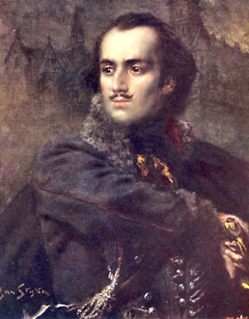
Kazimierz Michał Władysław Wiktor Pułaski of Ślepowron was a Polish nobleman, soldier and military commander who has been called, together with his counterpart Michael Kovats de Fabriczy, "the father of the American cavalry."

Andrzej Tadeusz Bonawentura Kościuszko was a Polish-Lithuanian military engineer, statesman, and military leader who became a national hero in Poland, Lithuania, Belarus, and the United States. He fought in the Polish–Lithuanian Commonwealth's struggles against Russia and Prussia, and on the US side in the American Revolutionary War. As Supreme Commander of the Polish National Armed Forces, he led the 1794 Kościuszko Uprising.

Charles-François du Périer Dumouriez was a French general during the French Revolutionary Wars. He shared the victory at Valmy with General François Christophe Kellermann, but later deserted the Revolutionary Army, and became a royalist intriguer during the reign of Napoleon as well as an adviser to the British government. Dumouriez is one of the names inscribed under the Arc de Triomphe, on Column 3.

Alexander Vasilyevich Suvorov was a Russian general in service of the Russian Empire. He was Count of Rymnik, Count of the Holy Roman Empire, Prince of the Kingdom of Sardinia, Prince of the Russian Empire and the last Generalissimo of the Russian Empire. Suvorov is considered one of the greatest military commanders in Russian history and one of the great generals of the early modern period. He was awarded numerous medals, titles, and honors by Russia, as well as by other countries. Suvorov secured Russia's expanded borders and renewed military prestige and left a legacy of theories on warfare. He was the author of several military manuals, the most famous being The Science of Victory, and was noted for several of his sayings. Several military academies, monuments, villages, museums, and orders in Russia are dedicated to him. He never lost a single battle he had commanded.
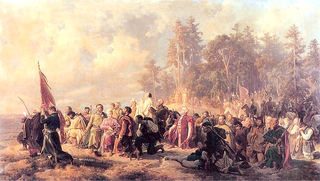
The Bar Confederation was an association of Polish nobles (szlachta) formed at the fortress of Bar in Podolia in 1768 to defend the internal and external independence of the Polish–Lithuanian Commonwealth against Russian influence and against King Stanislaus II Augustus with Polish reformers, who were attempting to limit the power of the Commonwealth's wealthy magnates. The founders of the Bar Confederation included the magnates Adam Stanisław Krasiński, Bishop of Kamieniec, Karol Stanisław Radziwiłł, Casimir Pulaski, his father and brothers and Michał Krasiński. Its creation led to a civil war and contributed to the First Partition of the Polish–Lithuanian Commonwealth. Maurice Benyovszky was the best known European Bar Confederation volunteer, supported by Roman Catholic France and Austria. Some historians consider the Bar Confederation the first Polish uprising.
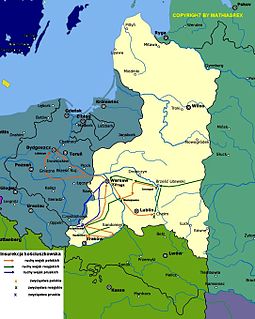
The Kościuszko Uprising, also known as the Polish Uprising of 1794 and the Second Polish War, was an uprising against the Russian Empire and the Kingdom of Prussia led by Tadeusz Kościuszko in the Polish–Lithuanian Commonwealth and the Prussian partition in 1794. It was a failed attempt to liberate the Polish–Lithuanian Commonwealth from external influence after the Second Partition of Poland (1793) and the creation of the Targowica Confederation.

Berek Joselewicz was a Polish Jewish colonel of the Polish Army during the Kościuszko Uprising. Joselewicz commanded the first Jewish military formation in modern history excluding Prince Potemkin's Israelovsky. He was also a merchant and financial agent of the Polish magnate Prince Massalski.

Jan Henryk Dąbrowski was a Polish general and statesman, widely respected after his death for his patriotic attitude, and described as a national hero who spent his whole life restoring the legacy of Poland.

Franciszek Ksawery Branicki was a Polish nobleman, magnate, French count, diplomat, politician, military commander, one of the leaders of the Targowica Confederation and a grand traitor who participated with the Russians in the dismemberment of his nation.

Józef Grzegorz Chłopicki was a Polish general who was involved in fighting in Europe at the time of Napoleon and later.

The Warsaw Uprising of 1794 or Warsaw Insurrection was an armed insurrection by the people of Warsaw early in the Kościuszko Uprising. Supported by the Polish Army, the uprising aimed to throw off control by the Russian Empire of the Polish capital city (Warsaw). It began on 17 April 1794, soon after Tadeusz Kościuszko's victory at the Battle of Racławice.
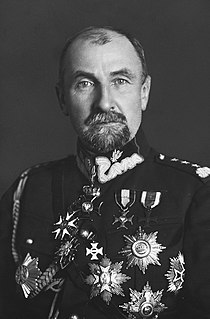
Count Tadeusz Jordan-Rozwadowski was a Polish military commander, diplomat, and politician, a general of the Austro-Hungarian Army and then the Polish Army.

For our freedom and yours (Polish: Za naszą i waszą wolność) is one of the unofficial mottos of Poland. It is commonly associated with the times when Polish soldiers, exiled from the partitioned Poland, fought in various independence movements all over the world. First seen during a patriotic demonstration to commemorate the Decembrists, held in Warsaw on January 25, 18311, it was most probably authored by Joachim Lelewel. The initial banner has the inscription in both Polish and Russian, and was meant to underline that the victory of Decembrists would also have meant liberty for Poland. The slogan got shorter with time; the original had the form 'In the name of God, for our freedom and yours' ('W imię Boga za Naszą i Waszą Wolność'). The original banner has been preserved in the collection of Muzeum Wojska Polskiego in Warsaw.

Lanckorona is a village located 30 kilometres (19 mi) south-west of Kraków in Lesser Poland. It lies on the Skawinka river, among the hills of the Beskids, 545 m (1,788 ft) above sea level. It is known for the Lanckorona Castle, today in ruins. Lanckorona is also known for the Battle of the Bar Confederation that took place at the castle and within a 4 km (2 mi) range south of the town borders on 22 February 1771. In recent years, Lanckorona has become a tourist attraction for the well preserved 19th century wooden houses in its centre. The township of Lanckorona was established by Casimir III the Great in 1336, to protect the road to Kraków, following the creation of new regional borders following the homage given by Mieszko I, Duke of Cieszyn to Wenceslaus II of Bohemia in 1291. Lanckorona lost its town rights on 13 July 1933 as its population declined.

The History of the Polish–Lithuanian Commonwealth (1764–1795) is concerned with the final decades of existence of the Polish–Lithuanian Commonwealth. The period, during which the declining state pursued wide-ranging reforms and was subjected to three partitions by the neighboring powers, coincides with the election and reign of the federation's last king, Stanisław August Poniatowski.

The Battle of Brest was a battle between Russian imperial forces and Polish rebels south-west of Brest, present-day Belarus, on 19 September 1794. It was part of the Kościuszko Uprising.
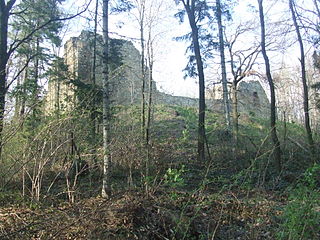
The Lanckorona Castle was built in the early 14th century in Lanckorona, Poland. It was damaged in several fires and during conflicts, especially in 1655 during the Swedish Deluge and Battle of Lanckorona in 1771.Jakub Derc led a pheasant revolt and was killed in Lanckorona.
Józef Bielak was a Lithuanian Tatar general, who fought in the Bar Confederation, the War in Defence of the Constitution and Kościuszko Uprising. He commanded the 4th Lithuanian Advance Guard Regiment from 1763 to his death in 1794.

Romualdas Giedraitis was a Polish-Lithuanian prince from the Lithuanian princely Giedraičiai family, who fought in the Bar Confederation, War of 1792 and the Kościuszko Uprising as part of the Grand Ducal Lithuanian Army. From mid-1812 to early 1813, Giedraitis was also the commander of the Lithuanian regiments raised during the French invasion of Russia. In early 1813, he was captured by the Russians and exiled to Arkhangelsk. In 1815, Alexander I of Russia amnestied Giedraitis and made him a Lieutenant general of the Army of Congress Poland.





















